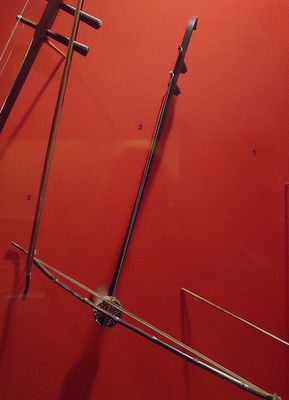Difference between revisions of "Erhu"
(Created page with "*''Chinese/Japanese'': 二胡 ''(èr hú / niko)'' The ''erhu'', a two-stringed bowed spike fiddle, is perhaps the most prominent or well-known of traditional Chinese musical...") |
|||
| (One intermediate revision by the same user not shown) | |||
| Line 1: | Line 1: | ||
| + | [[File:Erhu.jpg|right|thumb|320px|An ''erhu'' on display at the Metropolitan Museum]] | ||
*''Chinese/Japanese'': 二胡 ''(èr hú / niko)'' | *''Chinese/Japanese'': 二胡 ''(èr hú / niko)'' | ||
| Line 5: | Line 6: | ||
Closely related to the Okinawan ''[[kokyu (instrument)|kûchô]]'', the ''erhu'' incorporates a small round or hexagonal body (soundbox), covered typically in snakeskin, and a bow which is held between the two strings; unlike the bow of a Western instrument such as a violin, the ''erhu'' bow is not easily, or typically, removed, and is played between the strings rather than atop them. | Closely related to the Okinawan ''[[kokyu (instrument)|kûchô]]'', the ''erhu'' incorporates a small round or hexagonal body (soundbox), covered typically in snakeskin, and a bow which is held between the two strings; unlike the bow of a Western instrument such as a violin, the ''erhu'' bow is not easily, or typically, removed, and is played between the strings rather than atop them. | ||
| − | The ''erhu'' is often played as a solo instrument, as well as in traditional ensembles, modern orchestras, and in providing the music for theatre, including in ''[[jingju]]'' (Beijing opera). In the theatre, it someimes doubles the melody played by the ''[[jinghu]]'' (" | + | The ''erhu'' is often played as a solo instrument, as well as in traditional ensembles, modern orchestras, and in providing the music for theatre, including in ''[[jingju]]'' (Beijing opera). In the theatre, it someimes doubles the melody played by the ''[[jinghu]]'' ("capital fiddle") but at a lower octave, and is also used to accompany singing by female roles. |
In southern China and Taiwan, the instrument is often called a ''nanhú'' (南胡, "southern fiddle"). | In southern China and Taiwan, the instrument is often called a ''nanhú'' (南胡, "southern fiddle"). | ||
Latest revision as of 08:12, 20 August 2015
- Chinese/Japanese: 二胡 (èr hú / niko)
The erhu, a two-stringed bowed spike fiddle, is perhaps the most prominent or well-known of traditional Chinese musical instruments. It belongs to a family or category of spike fiddles known in Chinese as húqin.
Closely related to the Okinawan kûchô, the erhu incorporates a small round or hexagonal body (soundbox), covered typically in snakeskin, and a bow which is held between the two strings; unlike the bow of a Western instrument such as a violin, the erhu bow is not easily, or typically, removed, and is played between the strings rather than atop them.
The erhu is often played as a solo instrument, as well as in traditional ensembles, modern orchestras, and in providing the music for theatre, including in jingju (Beijing opera). In the theatre, it someimes doubles the melody played by the jinghu ("capital fiddle") but at a lower octave, and is also used to accompany singing by female roles.
In southern China and Taiwan, the instrument is often called a nanhú (南胡, "southern fiddle").
References
- Gallery labels, "Beijing Opera Orchestra," Musical Instruments gallery, Metropolitan Museum of Art.
